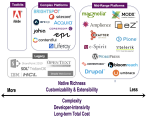Will Drupal Gardens let many flowers bloom?
Drupal Gardens, announced last year and in private beta since mid-January, is Acquia's "Drupal-as-a-service" offering, based on pre-release Drupal 7 code. I've been playing around with it a bit, and it's looking pretty polished. Even though, at first glance, it does look a lot like WordPress.
This is not entirely coincidental, it seems: it pretty much tries to do what wordpress.com does for blogging. The combination Automattic (the company), using WordPress (the open source software), to run wordpress.com (the blog service); is a lot like Acquia (the company), using Drupal (the open source software), to run drupalgardens.com -- the WCM service. One of the goals of the project is to create more buzz around Drupal (as if there weren't enough already), as well, of course, as earning a steady revenue stream.
Now, there are plenty of differences between Drupal and WordPress, but there are also huge overlaps -- many of the things you'd want to do with the one, you could make the other one do in a somewhat similar way. (Which is why both are covered in both our web content management and our community & collaboration research.) However, in their hosted services, the focus is much clearer: sites on wordpress.com look like blogs, quack like blogs, and, well, pretty much are blogs. Drupal Gardens is much more of a WCM/social cross-over; it can do blogs, but also regular websites, forums, etcetera (and all of those in the same site). That's a lot more flexible -- but it's also a lot harder to simplify for mainstream use.
So far, I think Drupal Gardens manages to do that -- but only to an extent. You can configure almost everything from its web interface. It's possible to create pretty complex sites, layouts, content types, use modules; in short, pretty much everything bar modifying the Drupal core -- without ever having to delve into code. Which is actually quite impressive. For example, I've seen plenty of theme editors, but rarely one that has the flexibility to define a complete CSS based design (including the box model, and the attributes of the boxes) from the on-line UI. This is a far cry from Google Sites' limited capabilities (we've come a long way since Geocities).
But is it easy to use? Not really. Let's put it this way: you wouldn't suggest your uncle to use it for the family website (you might advise Google Sites instead.) And on the other hand, if you're comfortable installing and modifying Drupal yourself, you'd probably find Gardens a bit limiting. Even though you can configure most of the settings through knobs and switches in the interface; if you're experienced, you may find it actually costs, rather than saves time doing it the "simple" way. The sweet spot is in the middle: those who need to build a lot of sites, with limited technical know-how, but willing to find out how to do it in Gardens. I'm guessing we'll see a lot of small businesses get a Drupal site, probably with the help of a small specialized integrator. But maybe the odd marketing team will start using it heavily to quickly whip up campaign sites, as well.
We'll have to wait and see. While writing this post, the flower I planted in the Garden went "Offline for infrastructure upgrade." It promises to be an interesting, and certainly affordable solution, but for now -- it's still in beta.








